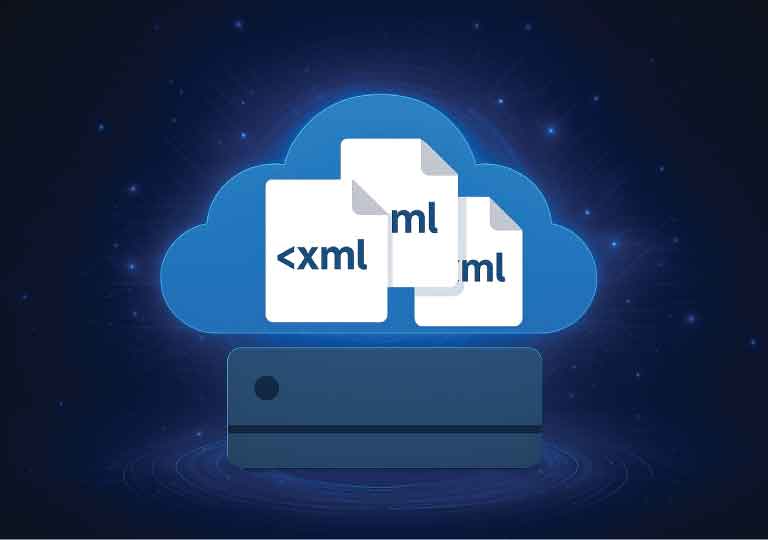In this article, we look at what XML has to do with online storage, how it influenced cloud services, and why it remains vital to the tech world’s ever-changing landscape today.
What is XML?
XML is a markup language that people can read and that computers can process. Unlike HTML that is all about displaying information, XML simply describes data and lets you decide how to display or handle that data on a given application on a given platform. XML was designed to be both human- and machine readable.
Example:
<person>
<name>John Doe</name>
<email>john@example.com</email>
</person>
XML and The Future of Internet Storage
Standardized Data Exchange
XML became the accepted “standard” for structured data exchange between online systems, at least during Web 1.0 and the early days of Web 2.0. It offered:
- Platform independence
- Cross-language support (Java, Python, .NET, etc.)
- Nested hierarchical structure for representing deeply nested information
This made it suitable for getting data in and out of cloud services, web services, and enterprise systems.
Foundation of Web Services (SOAP)
A number of early web services were built on the back of XML, with SOAP (Simple Object Access Protocol). SOAP messages are enveloped -- though with a little more structure and metadata in the envelope -- in XML, so that server and client can speak with each other, irrespective of the technologies at the core.
This made XML essential in:
- Banking APIs
- Enterprise resource planning (ERP) systems
- Government and health data transfers
Data Portability and Archiving
Mobility of data is the key in the cloud storage. XML is well-suited for this purpose due to its hierarchical format that makes it adaptable for:
- User settings/Logs/metadata export-import
- Storing data in an accessible and transparent format
- Transferring data across storage platforms without losing the data
To guarantee future compatibility and archive safety, ports do support XML/XML-Export/XML-Import.
Config Files and Cloud Infrastructure
XML is widely used in cloud services like AWS, Azure, and Google Cloud for:
- Configuration files (.xml, .plist, etc.)
- Infrastructure as code patterns (e.g., AWS Cloudformation pre-yaml)
- VM metadata and service definitions
This enables scripts and automated tools to easily parse and deploy configurations with confidence.
Cross-System Integration
The mixing and matching tools from multiple vendors, is almost de rigueur in enterprise storage and SaaS world. XML is intermediate, Data transfer layer in a data exchange of structured information:
- CRMs to ERPs
- Marketing automation to analytics platforms
- Local storage and cloud archives
Despite the ascension of JSON, XML limps along in enterprise applications because of its maturity, full validation, and namespace support.
XML vs. The Modern: Is XML Dead?
Modern web and app development favors less syntax-heavy formats such as JSON or YAML, today. But XML is still in use in places such as:
| Use Case | XML Still Preferred? |
|---|---|
| Enterprise Integrations | ✅ Yes |
| SOAP Web Services | ✅ Yes |
| Document-Based Storage (Word, Excel, etc) | ✅ Yes |
| Lightweight APIs | ❌ JSON preferred |
| Configuration (Modern DevOps) | ❌ YAML/JSON preferred |
Advantages Of Using XML For Online Storage
- Self-documenting: Somewhat self-explanatory without needing to consult a written manual or reference guide.
- Validation with DTD/XSD: Avoids errors thanks to strict format rules.
- Internationalized: Works well with multilingual or unicode data.
- Expandable: You can create your own tags and hierarchy.
The Future of XML in Storage
"Everyone is talking about lighter and better alternatives to XML (JSON and protobuf) XML will not be the choice for a pet project when you can make that is light and easy to use. It's robust, schema-aware, and will be around forever, so I suspect that XML will continue to play in a supporting role in:
- Data migrations
- Compliance-driven archiving
- Cross-platform integrations
- Secure and structured storage
Conclusion
The impact of XML on storing information online is huge; it’s led to some of the most widely adopted data exchange standards, has helped form the foundation of cross-platform compatibility and is used in the structure of digital archiving. While newer formats are the new hotness, XML still forms a rock-solid information environment for systems where exactitude, structure, and long-term interoperability really count.
No matter if you're dealing with cloud configurations or integrating business systems or archiving government records, XML is still quietly powering a lot of the back-end plumbing that keeps the web working today.
visit www.fileconvertz.com for XML conversion.